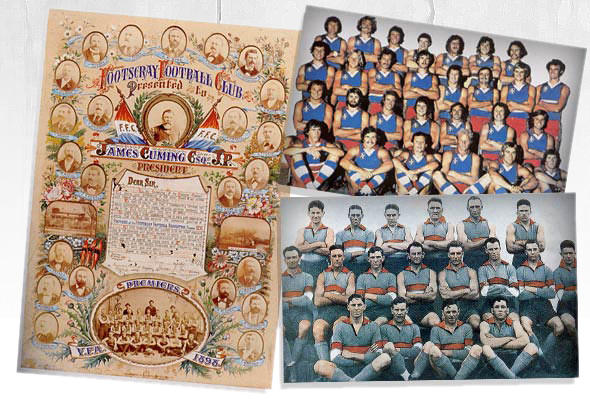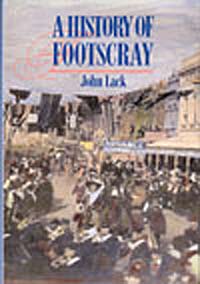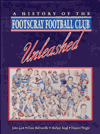Early History

FOOTSCRAY EARLY HISTORY
The Footscray Football Club is a famous old established Australian Sporting identity of well over 120 years standing. The clubs foundation year is not conclusively proven or unanimously agreed on with 1883, 1880 and even earlier offered as the commencement year. For many moons 1883 was the accepted view of the clubs birth although recently some historians have argued that the club is in fact older.
The team sprung from the name of its location, the Melbourne suburb of Footscray. Footscray was named after an English village in the county of Kent, the two worded Foots Cray.
I strongly advise anyone with an interest in both Footscray the place and Footscray the football club, to read (or better still read after buying them!) these two books.
- Unleashed – The History of the Footscray Football Club (1996)
- A History of Footscray (1991)


These two books provide an excellent account of the history of their subjects and explain the basis and foundations of Footscray.
The English name of Foots Cray evolved from a Saxon chieftain Godwin Fot. The landowner Godwin Fot was recorded in the Doomsday Book of 1086 for the invading monarch, the Norman King William 1 who was earlier just the Duke of Normandy.
William who 20 years ago at Senlac Hill defeated the reigning Saxon ruler King Harold at the famous 1066 Battle of Hastings and is forever more remembered as William the Conqueror rather than William 1.
The Godwin part of the Godwin Fot name has slipped from common usage in this situation but the Fot was to continue although it was to later alter from Fot to Foot. Nearby is the river Cray and whether at the time there was a ‘Bridge on the River Cray’ is unconfirmed, but what is known is that the town of Maidstone was nearby. Maidstone and Foots Cray were to have their names copied and be neighbours again in this new land 12,000 miles away from England.
As Fot evolved somehow into Foot in England, the Australian differentiation was for Foots Cray to become Footscray and in 1859 the town was to achieve the status of a municipality as Melbourne’s population expanded rapidly on the back of the Victorian Gold Rush.
Footscray grew and in the 1870’s civic minded citizens formed an Australian Rules football club for the municipality. Some historians claim that the original Footscray Football Club was founded in 1876. This has led to debate as to whether this was the same autonomous organisation in 1883, which has usually been the accepted defining year for the birth of the Footscray Football Club. The initial Footscray Football Club appeared to change its name to the Prince Imperial Football Club. The Prince Imperial was Louis Napoleon, the heir to the French throne. The Prince was killed during a confrontation with some Zulu warriors in Africa in 1879.
We today would consider this unusual for an Australian town of a British colony in the 1880’s being deferential to a French dignitary. Less than 70 years earlier the French and British were fighting each other in the Napoleonic Wars. This was the just another war between the English and the French in the centuries old history of antagonism between these two peoples which dates back to the earlier mentioned 1066 Battle of Hastings, during the era of our hero the great Saxon chieftain Godwin Fot. However the Prince Napoleon was with the English at the time of his death and was thus ‘A good guy’ so the Imperial name carried the day for a few years.
However the now named Prince Imperial did not encounter success and by 1882 it was decided that that name be dropped for the original Footscray. This is direct passage from page 11 of ‘Unleashed’
Lovett was Charlie Lovett (1863-1929) a local identity who played a major and pivotal role in the early days of the Footscray Football Club. Charlie Lovett would have a good claim as being the main man in the founding of the 1883 re –established Footscray Football Club.
Commencing in the Victorian Football Association, some years after that competition commenced in 1877, Footscray found it difficult to contend with the older more established clubs and were not to play finals football until 1897. That year the club were to finish third in this the first season of the smaller VFA after eight of her clubs has broken away to form a new competition- the Victorian Football League.
Footscray were now to embark on our glory years as Premierships and Grand Finals rained down on the team described as the ‘Bone Mill Fellows’, ‘The Saltwater Lads’ or more popularly the ‘Tricolours.’ The last name now taking over as Footscray’s nickname from the previous two titles along with the abbreviation from the back: Scray or its plural the ‘Scrays’
Season 1898 saw a Premiership come to Footscray, the clubs very first flag. 1954 is NOT the first triumph as so many still are yet to learn.
Footscray finished the season on top of the VFA ladder and it was to be North Melbourne as our opponents in the Grand Final. Heroic captain Dave De Coite was to lead his players to victory in a fierce encounter against the Shinboners. Arthur Armstrong widely considered the best man on the ground. This was to create problems for Armstrong, as he was a resident of North Melbourne playing for their opponents, which upset many from his Shinboner supporting neighbourhood. Some of his team mates that joyous day were Charlie Molyneaux, Billy Kruse, Charlie Brockwell, Bob Montgarrett and William ‘Ching’ Harris.
The next season was also a flag and Footscray were to complete three consecutive Premierships with success in 1900. They were now the undisputed biggest show in the VFA, the club that others aspired to become like.
Some moderate seasons were to follow again before Footscray’s fourth Premiership was claimed in 1908. Two years later saw another flag in 1910 and as the 1924 Grand Final approached, the Tricolours were looking at their ninth overall Premiership all to be achieved after over triumphs in seasons 1913,1919,1920 and 1923 If the 1924 Grand Final was a success, it would be our ninth flag in under a quarter of a century.
Happily it was a victory and Williamstown our defeated opponents. Soon another battle was to be fought and this was Footscray representing the cause of the old VFA against the upstarts of the VFL. A championship of Victoria game had been arranged earlier in 1924 from the request of Dame Nellie Melba as a fundraiser for the Limbless Soldiers Fund. It was Essendon, the VFL Premiers defending the League against Footscray, carrying the torch for the Association.
The Association were to feel proud as their team easily accounted for the League’s Premier. However the Association’s joy was to be short as the champion of their cause Footscray was within months to leave the Association and join the hated enemy, those upstarts of the VFL. After years of actively seeking to join the VFL, finally the goal of membership in that organisation was finally attained. Footscray were to leave the VFA and take their place as newcomers with Hawthorn and North Melbourne in an expanded VFL competition for 1925.
The new era in a big brave new world had arrived.

